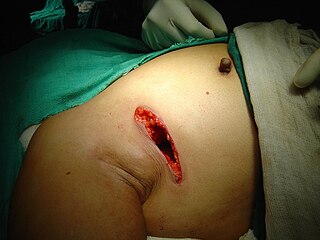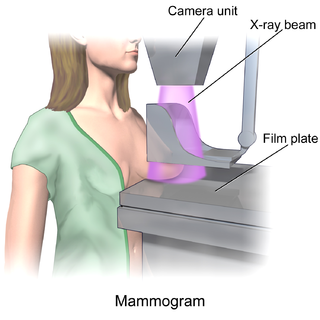
Mastectomy is the medical term for the surgical removal of one or both breasts, partially or completely. A mastectomy is usually carried out to treat breast cancer. In some cases, women believed to be at high risk of breast cancer have the operation as a preventive measure. Alternatively, some women can choose to have a wide local excision, also known as a lumpectomy, an operation in which a small volume of breast tissue containing the tumor and a surrounding margin of healthy tissue is removed to conserve the breast. Both mastectomy and lumpectomy are referred to as "local therapies" for breast cancer, targeting the area of the tumor, as opposed to systemic therapies, such as chemotherapy, hormonal therapy, or immunotherapy.

Breast cancer is a cancer that develops from breast tissue. Signs of breast cancer may include a lump in the breast, a change in breast shape, dimpling of the skin, milk rejection, fluid coming from the nipple, a newly inverted nipple, or a red or scaly patch of skin. In those with distant spread of the disease, there may be bone pain, swollen lymph nodes, shortness of breath, or yellow skin.

Mammography is the process of using low-energy X-rays to examine the human breast for diagnosis and screening. The goal of mammography is the early detection of breast cancer, typically through detection of characteristic masses or microcalcifications.

Invasive carcinoma of no special type, invasive breast carcinoma of no special type (IBC-NST), invasive ductal carcinoma (IDC), infiltrating ductal carcinoma (IDC) or invasive ductal carcinoma, not otherwise specified (NOS) is a disease. For international audiences this article will use "invasive carcinoma NST" because it is the preferred term of the World Health Organization (WHO).

The sentinel lymph node is the hypothetical first lymph node or group of nodes draining a cancer. In case of established cancerous dissemination it is postulated that the sentinel lymph nodes are the target organs primarily reached by metastasizing cancer cells from the tumor.

Radical mastectomy is a surgical procedure that treats breast cancer by removing the breast and its underlying chest muscle, and lymph nodes of the axilla (armpit). Breast cancer is the most common cancer among women. During the early twentieth century it was primarily treated by surgery, when the mastectomy was developed. However, with the advancement of technology and surgical skills in recent years, mastectomies have become less invasive. As of 2016, a combination of radiotherapy and breast conserving mastectomy are considered optimal treatment.

Ductal carcinoma in situ (DCIS), also known as intraductal carcinoma, is a pre-cancerous or non-invasive cancerous lesion of the breast. DCIS is classified as Stage 0. It rarely produces symptoms or a breast lump that can be felt, typically being detected through screening mammography. It has been diagnosed in a significant percentage of men.

Philip Strax was an American radiologist who pioneered the use of mammography to screen for early breast cancer. With his co-investigators, the statistician Sam Shapiro and the surgeon Louis Venet, he conducted a randomized controlled trial comparing outcomes of over 60,000 women who received either mammogram and clinical breast exam or standard medical care. The first results of this study were published in the Journal of the American Medical Association (JAMA) in 1966. The study demonstrated that screening mammograms, which are routine periodic mammograms of asymptomatic women, could find breast cancer at an early enough stage to save lives. For this research Strax and Shapiro shared the Kettering Prize for outstanding contributions to cancer diagnosis or treatment in 1988.
Breast cancer management takes different approaches depending on physical and biological characteristics of the disease, as well as the age, over-all health and personal preferences of the patient. Treatment types can be classified into local therapy and systemic treatment. Local therapy is most efficacious in early stage breast cancer, while systemic therapy is generally justified in advanced and metastatic disease, or in diseases with specific phenotypes.

Breast-conserving surgery refers to an operation that aims to remove breast cancer while avoiding a mastectomy. Different forms of this operation include: lumpectomy (tylectomy), wide local excision, segmental resection, and quadrantectomy. Breast-conserving surgery has been increasingly accepted as an alternative to mastectomy in specific patients, as it provides tumor removal while maintaining an acceptable cosmetic outcome. This page reviews the history of this operation, important considerations in decision making and patient selection, and the emerging field of oncoplastic breast conservation surgery.

Molecular breast imaging (MBI), also known as scintimammography, is a type of breast imaging test that is used to detect cancer cells in breast tissue of individuals who have had abnormal mammograms, especially for those who have dense breast tissue, post-operative scar tissue or breast implants.

Male breast cancer (MBC) is a cancer in males that originates in their breasts. Males account for less than 1% of new breast cancers with about 20,000 new cases being diagnosed worldwide every year. Its incidence rates in males vs. females are, respectively, 0.4 and 66.7 per 100,000 person-years. The worldwide incidences of male as well as female breast cancers have been increasing over the last few decades. Currently, one of every 800 men are estimated to develop this cancer during their lifetimes.

Oncology is a branch of medicine that deals with the study, treatment, diagnosis, and prevention of cancer. A medical professional who practices oncology is an oncologist. The name's etymological origin is the Greek word ὄγκος (ónkos), meaning "tumor", "volume" or "mass". Oncology is concerned with:

Deborah M. Axelrod is an American surgeon who specializes in breast cancer.

In medicine, breast imaging is a sub-speciality of diagnostic radiology that involves imaging of the breasts for screening or diagnostic purposes. There are various methods of breast imaging using a variety of technologies as described in detail below. Traditional screening and diagnostic mammography uses x-ray technology and has been the mainstay of breast imaging for many decades. Breast tomosynthesis is a relatively new digital x-ray mammography technique that produces multiple image slices of the breast similar to, but distinct from, computed tomography (CT). Xeromammography and galactography are somewhat outdated technologies that also use x-ray technology and are now used infrequently in the detection of breast cancer. Breast ultrasound is another technology employed in diagnosis and screening that can help differentiate between fluid filled and solid lesions, an important factor to determine if a lesion may be cancerous. Breast MRI is a technology typically reserved for high-risk patients and patients recently diagnosed with breast cancer. Lastly, scintimammography is used in a subgroup of patients who have abnormal mammograms or whose screening is not reliable on the basis of using traditional mammography or ultrasound.
Souzan El-Eid is a breast surgical oncologist at Comprehensive Cancer Centers of Nevada (CCCN), and serves as the medical director of the Breast Care Center at Summerlin Hospital, cancer liaison physician for the cancer program and co-chair of the Breast Tumor Board at Summerlin Hospital. She is also the president elect for Clark County Medical Society. She is an Adjunct Associate Professor of General Surgery at Touro University Nevada and has served as principal investigator for several clinical research studies. She is the first breast surgeon in Las Vegas certified in both ultrasound and stereotactic breast biopsies.
Laura Esserman is a surgeon and breast cancer oncology specialist. She is the director of the Carol Franc Buck Breast Care Center at the University of California, San Francisco School of Medicine. She leads the I-SPY trials, Athena Breast Health Network and the WISDOM study. Esserman is an inductee in the Giants of Cancer Care, 2018, for Cancer Diagnostics and the "less is more" approach. She performs live in the show "Audacity" which she co-created. She is also known as the "singing surgeon" for singing to her patients as they go under anesthesia.
Emilia Dauway MD, FACS, FRACS is an American trained surgeon who is practicing general, breast and oncologic surgery in Australia. Dauway was co-inventor of the use of radioactive seeds in the breast to localise non-palpable breast cancers and the first in Australia to use magnetic seeds instead of radioactive seeds. This technique replaces hookwire or needle localisation improving patient safety, outcomes and satisfaction. The method was patented by the University of South Florida while Dauway was a fellow of surgical oncology. The method has been used since 1999 and has improved with the development of modern equipment. Dauway is also a Yoga Instructor, a Keynote speaker and is founder/director of Restore More, a non-profit initiative which provides education and funding to women in regional and geographically disadvantaged areas for breast cancer treatment and reconstruction.

Armando Elario Giuliano is a surgical oncologist, surgeon scientist and medical professor in Los Angeles, California, United States of America. He is the Linda and Jim Lippman Chair in Surgical Oncology and co-director of Saul and Joyce Brandman Breast Center at Cedars-Sinai Medical Center, Los Angeles.
Somashekhar SP is an Indian robotic surgeon, author and chairman of medical advisory board at Aster DM Healthcare - GCC & India. He is also the global director of Aster International Institute of Oncology in GCC & India. He is the president of the Association of Breast Surgeons of India, editor in chief of the IJGO Springer Indian Journal of Gynec Oncology and council member of The Association of Surgeons of India. He is also the editor of Annals of Breast Diseases.















